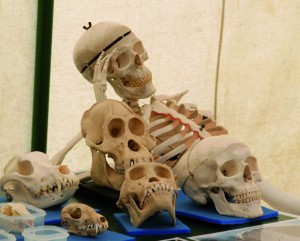MONDAY, 3 OCTOBER 2011
Cambridge hands-on science (or, to give it its rather fitting acronym, CHaOS) is a student- and alumni-run organisation which aims to bring fun, interesting and interactive science demonstrations to children all over the UK. It sets out to enlighten those who might not otherwise experience the more practical side of science.In 1997, a group of Cambridge undergraduates organised an event during the Cambridge Science Festival featuring hands-on experiments, calling it Crash, Bang, Squelch! In 2002, the committee decided to take the experiments to six venues on the south coast, and the CHaOS Science Roadshow was born. In 2011, Crash, Bang, Squelch! welcomed over two thousand visitors on a five week tour around the country, with around fifteen demonstrators volunteering at any event.
CHaOS demonstrators range from first years to PhD students to alumni—one of whom, Dave Ansell, has a garage filled with CHaOS and other science-related odds and ends. It includes lathes, a box of light bulbs with an intensity equivalent to sunlight, and a bazooka powered by a vacuum cleaner. This year I joined the CHaOS Science Roadshow for the last three weeks of the tour.
Since CHaOS is run by volunteers and funded by sponsorship, we spent most of our nights camping, apart from a few committee members who (madly) chose to sleep outside under an open marquee. This led to a friendly, sociable atmosphere when the weather was fair, with barbecues, seemingly endless quantities of fajitas, roasted marshmallows and days off spent relaxing or even swimming. However, heavy rain occasionally forced us to huddle inside the marquee with hot chocolate or repair leaking tents in the dark, but at least we could shelter in a warm pub for dinner.
Most demonstrators, including myself, found the experiments even more fascinating than the children—though it was understandable that most people didn’t get quite as excited as me about rocks and fossils! I also enjoyed launching home-made water rockets constructed from fizzy drink bottles, particularly when replacing the pump and bung made them so powerful I had to repair the rockets several times. It never stopped being entertaining watching every child in the room jump whenever the electrolysis experiment made a small explosion as hydrogen and oxygen were recombined to make water. I learnt a lot by watching other demonstrators explain their experiments, including why a crisp packet sparks and shrinks when cooked in a microwave, how microwaving a brillo pad can produce a plasma, or why placing a spinning mesh around a fire can turn it into a spectacular flame tornado.
The venues ranged from schools, to museums, to festivals, and all were very rewarding—particularly when I could tell that a group of children were enjoying the experiment that I was demonstrating. My favourite venue was CamJam, a scouting jamboree held just outside Huntingdon. For some reason many of the scouts thought it hilarious to wear a particular ‘cuddly microbe’ (check out www.giantmicrobes.com) as a moustache, until reading that it was diarrhoea! The CHaOS team also successfully prevented the jamboree’s inflatable stage from escaping during a very blustery storm, while a dozen security personnel looked on. Plus Boris the Skeleton, a new favourite, appeared on the radio, posed on the climbing wall and walked on stilts. Unsurprisingly, he is not the first CHaOS skeleton.
I enjoyed my three weeks with CHaOS so much that I’ve found myself considering joining next year’s committee. I would recommend demonstrating at CHaOS events to anyone with an interest in science and a love for children—if this sounds like you, more information can be found at www.chaosscience.org.
Aaron Barker is a 4th year student in the Department of Earth Sciences


